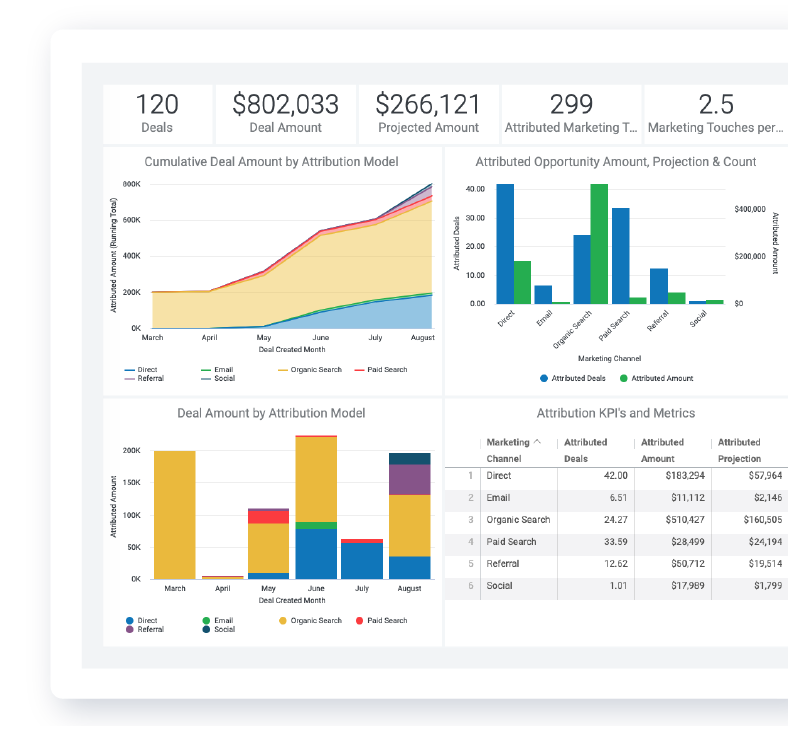Marketing Attribution
By embracing DemandJumps approach to SEO, we have been able to increase our organic rankings within just 2 weeks of implementing recommendations. This helped us see a 22% increase in organic search month-over-month.
Robert Jacko Vice President Digital Marketing @ Homage
DemandJump has become a crucial extension of our marketing team, providing game changing insights to fuel and propel all aspects of our digital marketing efforts. The DemandJump platform is a must have, we are seriously impressed.
Tim Lavinder Director of Ecommerce @ Hotsox
We used to spend hours looking for insights in dozens of tools and reports. Now we log into one place to find out what customers are doing and how to meet them where it matters most.
Zach Roop Digital Marketing Manager @ Dometic
We use DemandJump recommendations as our digital to-do list. We love going in and seeing the recommendations and knowing what to do next.
JoLynda Wilson Marketing Director @ IWC
Our Customers Love Attribution






Account-Based Attribution
Eliminate wasted time and spend. With DemandJump's automated account-based attribution
solution you will know with certainty which efforts are driving ROI.
Measure Your Marketing Performance
Find out which of your marketing efforts are making the biggest impact. See which channel drove consumers to you, the pages they visited, and all touchpoints along their path to purchase.

From Marketing Spend to Actual Pipeline Value
When a lead becomes a customer, you need to know which marketing channel or campaign should receive credit, and account-based attribution will give you the answers.

Organic & Paid Search Keyword Attribution
Beyond channel, campaign, and content attribution, you will finally see which organic and paid keywords are generating deal and opportunity revenue.

See a Demo of Attribution
Hubspot Attribution
B2B marketing teams often lose visibility to leads once they enter the sales funnel. This results in wasting spend on campaigns that drive leads but zero closed won revenue. The only way your B2B team can truly understand what campaigns are driving deal creation and closed won revenue is with a Hubspot lead attribution solution. A solution that provides not only contact attribution, but account based attribution.
Here at DemandJump, we set out to solve this sales opportunity attribution blind spot. Our Hubspot CRM Attribution platform provides campaign level attribution along with suggested budget adjustments to improve performance. This automated B2B attribution solution will give your team hours back in their day while leading to improved campaign performance.
This Hubspot integration gives you campaign level closed won attribution with the click of a button. See what campaigns are driving leads, deals, opportunities and closed won revenue. Save time, save money, and drive more valuable leads.
How do I use Hubspot attribution to inform a B2B inbound marketing strategy?
A quality inbound marketing strategy for B2B companies will incorporate data on attribution throughout the sales funnel. The goal of inbound marketing revolves around providing customers with the information they seek online, demonstrating to them that you have the power to resolve their pain points so that they turn to you when they are ready to make a purchase.
DemandJump’s HubSpot attribution, sales opportunity attribution, lead attribution, and closed won attribution all provide insight into what touchpoints lead to pipeline and revenue. By tracking the touchpoints and types of contact that prepare customers to become contacts and leads, then what maintains their interest so they evolve into sales opportunities, and then finally what convinces them to close all provide concrete information to inform future content. More importantly DemandJump’s content attribution will tell you exactly which pieces of content are driving revenue and inform on competitive gaps - what to create next.
Prior to having this data, much of inbound marketing was a guessing game. Brands had to make their best estimates on the types of content customers wanted to see and what would address their pain points to build their trust with a particular company.
Now, with the data that can be derived through the platform, businesses can gain a significantly more precise view of not only what interests the customers, but also what helps to inspire trust and convinces them to move to the next stage of the buyer's journey.
Building a strong brand involves a keen understanding of customers and then producing the content and experiences that they want to see. The more equipped brands are to understand their target audience and then engage them, the more effective they will be at bringing in new customers and maximizing the efficiency of their marketing budget and resources. The power of attribution data tracking lies at the heart of this strategy.
Understanding HubSpot Attribution
HubSpot offers brands sales, marketing, and service tools combined in a single location. This makes it easier for businesses to utilize inbound marketing, empowering them to see what interests customers and how to move them through the sales funnel.
From a marketing perspective, brands have tools that help them create critical promotional components, such as blog posts, landing pages, and social media posts. The platform can also help with marketing automation and website traffic analytics. For those in sales, employees can complete tasks such as email sequences and tracking, automate various sales tasks, manage meeting scheduling, and run deal forecasting numbers to enhance their engagement with potential customers. HubSpot sales attribution then provides insight into the success of different sales activities and rep performance tracking provides keen insight on the activities and success rates of those in the sales departments.
By providing these diverse strategies, HubSpot functions as both a CRM and a CMS. As a CRM, it helps brands with contact management, including keeping company records and recording activity. As a CMS, it enhances the ability of brands to create web pages thanks to features such as drag and drop editors, contact attribution report builders, and local website development.
The cost of using HubSpot can vary considerably from company to company. The platform offers a variety of different prices based on the level of service you need-- from starter to enterprise level. It also gives you the option of purchasing individual features, such as the marketing software, or bundling the different services together and getting the CRM, marketing, and sales features altogether. For the bundle packages, prices start as low as $50 per month and scale up to over $4,000 per month depending upon size.
What is CRM attribution?
A CRM platform, which allows brands to track the information and data associated with different customers and contacts, can help companies organize and analyze the data points that lead to a prospect converting to a customer. Those who use the Hubspot CRM are interested in carefully monitoring their leads and customers so that they can provide better marketing and service for them.
As companies improve their understanding of how customers behave and what they want to see during their path to purchase, the easier it is to provide the content and experiences that will attract more leads and revenue. It also makes it easier to provide excellent service to existing customers. This is where including a company’s CRM data in marketing attribution data and reporting becomes vital to understanding how marketing efforts drive revenue.
Understanding CRM attribution adds a rich level of data that enhances marketing and sales efforts. To effectively use these benefits, organizations should familiarize themselves with the different types of attribution so they can ensure that they are looking at the data in the way that tells a story they can act on.
Attribution as a whole requires collecting data points on the touchpoints a customer has with a company before performing a specific conversion event, such as converting into a customer. Historically, this has been a much harder task for B2B companies. In more recent years, with more purchases being made online, B2C companies have had the easier task of tracking a consumer from first touch all the way through to purchase.
However, it is a bit more complicated for B2B companies. Oftentimes a lead will come in, get handed to sales, multiple meetings, handful of calls, and then end up closed won or closed lost in the CRM But that doesn’t tell the whole story - the original marketing channel source is often lost or diminished, especially in companies with long sales cycles. B2B companies need the ability to track a deal all the way through the sales funnel - at the contact, lead, and company level.
As the lead moves further through the sales funnel, tracking the touchpoints that influence those who convert into customers then finishes the sequence by providing a complete look at the sales funnel.
What are the benefits of different types of Hubspot attribution?
Customers who want to gain a more thorough understanding of customer behavior and conversions turn to HubSpot CRM to gain this level of insight and information. It can be used by businesses of all sizes. In order to get a better understanding of how your contacts, accounts and leads are converting, try the DemandJump Attribution Platform.
DemandJump’s Hubspot attribution solution allows customers to bring together attribution models across all levels of their sales funnels. For B2B brands, using account level attribution, where the touchpoints of everyone from a single company are group and tracked together, can be particularly helpful to make sense of the data.
Brands can also look at the lead or contact level, but it is often more insightful for budget forecasting purposes to look at it at the account level. Within each stage of these attribution views, there are different models to track the touchpoints and behavior of customers.
- First touch attribution looks at the touchpoint that first brought customers to the brand, giving the the credit for the eventual conversion to that first touchpoint, but discounts the importance of the touchpoints that keep the lead engaged.
- Last touch attribution models look at the last touchpoint that engaged a customer before they converted in a meaningful way, but discounts the earlier touchpoints that sparked their interest.
- Finally, various multi-touch attribution models try to understand how the different touchpoints work together to provide more meaningful credit to the touchpoints throughout the steps that led to the conversion.
Customers turn to DemandJump’s HubSpot CRM Attribution because they appreciate the convenience of this funnel information tied into their customer relationships data, providing a more complete picture of their funnel.
How do I use Hubspot marketing attribution data?
With DemandJump’s HubSpot Attribution solution, organizations can accomplish an intensive level of data analysis without becoming overwhelmed. As they become better acquainted with their B2B marketing funnel, they gain greater insight into the types of material and interactions that entice and interest their prospective customers, which therefore prepare them to create highly-effective marketing materials.
The data pulled from HubSpot provides companies with distinctive advantages.
- They gain important insight into the type of touchpoints that interest customers, guiding their future marketing and sales efforts. This allows them to avoid wasting money on efforts that do not succeed.
- The company also better understands how to build out their sales funnels to entice an increasing number of customers to their brand. Since they better understand what customers want to see, they can create more material that addresses these pain points thereby improving and strengthening their sales funnel.
- Organizations will improve their ROI on marketing campaigns, as they can scale their marketing and sales efforts to reflect those that are most effective, spending their marketing budget and resources wisely and boosting their ROI.
The data the attribution models provide is step one. The key is taking advantage of the wealth of information that can be obtained to power customers through the B2B sales pipeline stages and increase conversions.
How do I customize my HubSpot attribution reporting?
To get the most out of the attribution reporting, brands need to make sure that the reporting accurately reflects their unique business goals. This includes outlining precisely what the touchpoints that their company offers customers, the types of conversions they want to track, and how they define customers at different stages of the sales funnel. Fortunately, HubSpot offers the potential for considerable customization, ensuring that the information gathered will help your business thrive - and more importantly - DemandJump pulls that data into the platform for reporting.
DemandJump will use attribution modeling to calculate the likelihood of a customer converting based on their position and behavior at a given stage in the funnel. Then using this information, DemandJump’s HubSpot attribution reporting allows you to create customized reports that deliver the data that matters the most to your organization. Within these reports, you can filter your data and display different formats to help you capture the information that most impacts specific people at your organization. For example, your HubSpot sales attribution reports may look different than those produced for the marketing teams.
The platform has multi-touch attribution reports built into it, allowing you to customize the information gathered for different touchpoints, providing a more complete view of behavior throughout the funnel.
To enhance your business planning, the contact attribution reports will provide you with concrete information about the value of the different types of interactions that customers have with you. This then allows you to put the pipeline strategies discussed previously to use, enhancing your business growth.
Those interested in learning more about how DemandJump’s HubSpot attribution reporting can help brands build a strong marketing and sales strategy, should sign up for a 7 day free trial above, or get a free demo.
Marketing Attribution Resources
Marketing AttributionAttribution Tracking
B2B Marketing Attribution
Hubspot Attribution
Marketing Campaign Influence
Mobile Attribution
Multi Touch Attribution
Offline Attribution
Sales Forecasting
Sales Opportunity Attribution
The Future of Data-Driven Marketing
Opportunities of Internet Marketing
Other Resources
Channel Optimization
Consumer Behavior
Consumer Insights
Consumer Insights and Analytics
Competitor Analysis Tools
Content Marketing
Content Strategy
Cross-Channel Analytics
Customer Insight Research Techniques
Customer Journey Map
Market Intelligence
Marketing Analytics Techniques
Market Research
Marketing Attribution
Opportunities of Internet Marketing
Types of Consumer Insights





